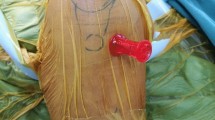Abstract
The question of whether ampicillin and sulbactam are able to penetrate sufficiently into costal cartilage tissue was investigated in 21 children undergoing surgery for funnel chest malformations. The concentrations of both compounds were determined in the core and mantle pieces of samples taken 45 min or 120 min after infusion of ampicillin/sulbactam (33.3/16.7 mg/kg bodyweight) preoperatively for antibiotic prophylaxis. Ampicillin was determined by bioassay and sulbactam was determined by gaschromatography/mass spectrometry. Mean concentrations of ampicillin were 23.3 mg/kg and 10.4 mg/kg at 45 min and at 27.4 mg/kg and 7.8 mg/kg 120 min in the mantle and core piece, respectively. Mean concentrations of sulbactam were at the same time 21.3 mg/kg and 9.7 mg/kg and 17.5 mg/kg and 11.9 mg/kg, respectively. These values indicate that both compounds achieve high concentrations even in bradytrophic tissue such as cartilage. The concentrations exceed the MIC values of important bacterial pathogens involved in postoperative wound infections. Therefore ampicillin protected by sulbactam appears to be a well-suited agent for perioperative prophylaxis in thoracic surgery.
Zusammenfassung
Die Frage, ob Ampicillin und Sulbactam in ausreichendem Maße in den Rippenknorpel penetrieren, wurde bei 21 Kindern, welche sich einer operativen Trichterbrust-Korrektur unterziehen mußten, untersucht. Hierzu wurden die Konzentrationen der beiden Substanzen jeweils im äußeren und inneren Anteil von Knorpelproben gemessen, welche entweder ca. 45 min oder ca. 120 min nach intravenöser Gabe von Ampicillin/Sulbactam (Dosierung 33,3/16,7 mg/kg Körpergewicht) gewonnen wurden. Ampicillin wurde mittels Bioassay und Sulbactam mittels Gaschromatographie/Massenspectometrie bestimmt. Die mittleren Konzentrationen von Ampicillin im äußeren bzw. im inneren Probenanteil waren nach 45 min 23,3 mg/kg bzw. 10,4 mg/kg und nach 120 min 27,4 mg/kg bzw. 7,8 mg/kg. Die entsprechenden Werte für Sulbactam zu denselben Zeitpunkten waren 21,3 mg/kg bzw. 9,7 mg/kg und 17,5 mg/kg bzw. 11,9 mg/kg. Die gemessenen Werte zeigen, daß beide Substanzen hohe Konzentrationen auch in bradytrophen Geweben wie zum Beispiel Knorpel erreichen. Diese Konzentrationen übersteigen die MHK-Werte der bei postoperativen Wundinfektionen bedeutsamen Erreger. Sulbactam-geschütztes Ampicillin erscheint für die perioperative Prophylaxe bei thoraxchirurgischen Eingriffen gut geeignet.
Similar content being viewed by others
References
DiPiro, J. T., Record, K. E., Schanzenbach, K. S., Bivins, B. A. Antimicobial prophylaxis in surgery, pt. 2: cardiac, vascular and thoracic surgery. Am. J. Hosp. Pharm. 38 (1981) 487–489.
English, A. R., Retsema, J. A., Girard, A. E., Lynch, J. E., Barth, W. E. CP 45899, a β-lactamase-inhibitor that extends the antibacterial spectrum of β-lactams: initial bacteriological characterization. Antimicrob. Agents Chemother. 14 (1978) 414–419.
Retsema, J. A., English, A. R., Girard, A. E., Lynch, J. E., Anderson, M., Brennan, L., Cimochowski, C., Faiella, J., Norcia, W., Sawyer, P. Sulbactam/ampicillin:in vitro spectrum, potency, and activity in models of acute infection. Rev. Inf. Dis. (Clin. Inf. Dis.) 8 (Suppl. 5) (1986) 528–542.
Wertzel, H., Sowoboda, L., Joos-Würtemberger, A., Frank, U., Hasse, J. Perioperative prophylaxis in general thoracic surgery. Thorac. Cardiovasc. Surgeon 40 (1992) 326–329.
Wildfeuer, A., Müller, V., Springsklee, M., Sonntag, H.-G. Pharmacokinetics of ampicillin and sulbactam in patients undergoing heart surgery. Antimicrob. Agents Chemother. 35 (1991) 1772–1776.
Foulds, G., Stankewich, J. P., Marshall, D. C., O'Brien, M. M., Hayes, S. L., Weidler, D. J., McMahon, F. G. Pharmacokinetics of sulbactam in humans. Antimicrob. Agents Chemother. 23 (1983) 692–699.
Wildfeuer, A., Schwiersch, U., Engel, K., von Castell, E., Schilling, A., Potempa, J., Lenders, H. Pharmacokinetics of sulbactam and ampicillin intravenously applied in combination of healthy volunteers and patients. Arzneim. Forsch./Drug Res. 38 (1988) 1640–1643.
Frank, U., Daschner, F. D. In vitro activity of sulbactam plus ampicillin against hospital isolates of coagulase-negative staphylococci andAcinetobacter spp. Infection 17 (1989) 272–274.
Author information
Authors and Affiliations
Additional information
This paper was presented in part as a poster at the 6th European Congress of Clinical Microbiology and Infectious Diseases, 28 to 31 March 1993, Seville (abstract 491).
Rights and permissions
About this article
Cite this article
Meier, H., Springsklee, M. & Wildfeuer, A. Penetration of ampicillin and sulbactam into human costal cartilage. Infection 22, 152–155 (1994). https://doi.org/10.1007/BF01739028
Issue Date:
DOI: https://doi.org/10.1007/BF01739028




